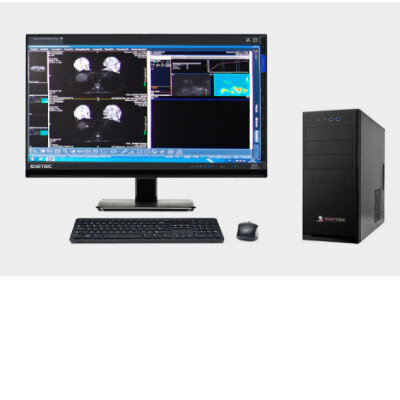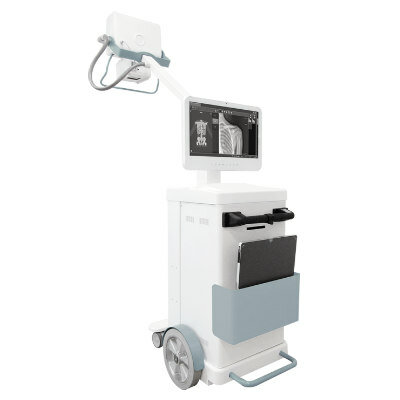Hybrid Nanomaterial Platform Effectively Kills Cancer Cells
|
By MedImaging International staff writers Posted on 27 Aug 2018 |

Image: A new study claims magnetite-gold hybrid nanomaterials advance theranostic therapies (Photo courtesy of NUST-MISiS).
A magnetite-gold particle hybrid nanomaterial could serve as a universal platform to both detect cancer cells and target drug delivery to kill them, claims a new study.
Developed at the Russian National University of Science and Technology (NUST-MISiS; Moscow, Russia), the University of Duisburg-Essen (Germany), and other institutions, the hybrid nanomaterial is the result of successful epitaxial growth of 25 nm octahedral-shaped magnetite (Fe3O4) nanocrystals on 9 nm gold (Au) seed nanoparticles, using a modified wet-chemical synthesis. The nanoparticles exhibit bulk-like magnetic properties and an octahedral spatial morphology resembling a so-called “nanodumbbell” that is capable of carrying almost any drug to a tumor cell.
The nanoparticles can thus provide two functional surfaces. For instance, they could be conjugated with two fluorescent dyes, or a combination of drug and dye, thus allowing for simultaneous tracking of the nanoparticle vehicle and the drug cargo both in-vitro and in-vivo. For the study, the researchers verified delivery to tumors and payload release in real time using intravital microscopy. Replacing the dyes with cell-specific molecules and drugs could make the Fe3O4-Au hybrids a unique platform for theranostics, claim the researchers.
For example, if the pathogenic cells are tagged with magnetic nanoparticles, they can be diagnosed with the help of magnetic resonance imaging (MRI) and subsequently destroyed using either a chemotherapy drug or via a strong magnetic field that could heats and kills cancer cells. Preliminary laboratory tests in mice with grafted tumors have already been completed, and the most optimistic researchers on the project say it will be possible to proceed to pre-clinical trials in just two to three years. The study was published on July 26, 2018, in Nature Scientific Reports.
“Hybrid materials for theranostics are increasingly attracting attention since they enable the combination of different properties and functions in one multipurpose hybrid material. In particular, high adaptability is achieved by controlling the surface chemistry,” concluded lead author Mariya Efremova, PhD, of NUST-MISiS, and colleagues. “Due to biocompatibility, Fe3O4 and Au are the materials of choice for therapeutic and diagnostic dual use. Such NPs represent a unique platform for modern theranostics, comprising the diagnostics function together with the ability for studying the cargo and vehicle functions separately and in conjugation.”
Theranostics uses specific biological pathways to acquire diagnostic images and deliver a therapeutic dose of radiation. Once a specific diagnostic test shows a particular molecular target on a tumor, the therapy agent can be specifically targeted to that receptor, providing a more targeted and efficient form of pharmacotherapy.
Related Links:
Russian National University of Science and Technology
University of Duisburg-Essen
Developed at the Russian National University of Science and Technology (NUST-MISiS; Moscow, Russia), the University of Duisburg-Essen (Germany), and other institutions, the hybrid nanomaterial is the result of successful epitaxial growth of 25 nm octahedral-shaped magnetite (Fe3O4) nanocrystals on 9 nm gold (Au) seed nanoparticles, using a modified wet-chemical synthesis. The nanoparticles exhibit bulk-like magnetic properties and an octahedral spatial morphology resembling a so-called “nanodumbbell” that is capable of carrying almost any drug to a tumor cell.
The nanoparticles can thus provide two functional surfaces. For instance, they could be conjugated with two fluorescent dyes, or a combination of drug and dye, thus allowing for simultaneous tracking of the nanoparticle vehicle and the drug cargo both in-vitro and in-vivo. For the study, the researchers verified delivery to tumors and payload release in real time using intravital microscopy. Replacing the dyes with cell-specific molecules and drugs could make the Fe3O4-Au hybrids a unique platform for theranostics, claim the researchers.
For example, if the pathogenic cells are tagged with magnetic nanoparticles, they can be diagnosed with the help of magnetic resonance imaging (MRI) and subsequently destroyed using either a chemotherapy drug or via a strong magnetic field that could heats and kills cancer cells. Preliminary laboratory tests in mice with grafted tumors have already been completed, and the most optimistic researchers on the project say it will be possible to proceed to pre-clinical trials in just two to three years. The study was published on July 26, 2018, in Nature Scientific Reports.
“Hybrid materials for theranostics are increasingly attracting attention since they enable the combination of different properties and functions in one multipurpose hybrid material. In particular, high adaptability is achieved by controlling the surface chemistry,” concluded lead author Mariya Efremova, PhD, of NUST-MISiS, and colleagues. “Due to biocompatibility, Fe3O4 and Au are the materials of choice for therapeutic and diagnostic dual use. Such NPs represent a unique platform for modern theranostics, comprising the diagnostics function together with the ability for studying the cargo and vehicle functions separately and in conjugation.”
Theranostics uses specific biological pathways to acquire diagnostic images and deliver a therapeutic dose of radiation. Once a specific diagnostic test shows a particular molecular target on a tumor, the therapy agent can be specifically targeted to that receptor, providing a more targeted and efficient form of pharmacotherapy.
Related Links:
Russian National University of Science and Technology
University of Duisburg-Essen
Latest General/Advanced Imaging News
- New AI Method Captures Uncertainty in Medical Images
- CT Coronary Angiography Reduces Need for Invasive Tests to Diagnose Coronary Artery Disease
- Novel Blood Test Could Reduce Need for PET Imaging of Patients with Alzheimer’s
- CT-Based Deep Learning Algorithm Accurately Differentiates Benign From Malignant Vertebral Fractures
- Minimally Invasive Procedure Could Help Patients Avoid Thyroid Surgery
- Self-Driving Mobile C-Arm Reduces Imaging Time during Surgery
- AR Application Turns Medical Scans Into Holograms for Assistance in Surgical Planning
- Imaging Technology Provides Ground-Breaking New Approach for Diagnosing and Treating Bowel Cancer
- CT Coronary Calcium Scoring Predicts Heart Attacks and Strokes
- AI Model Detects 90% of Lymphatic Cancer Cases from PET and CT Images
- Breakthrough Technology Revolutionizes Breast Imaging
- State-Of-The-Art System Enhances Accuracy of Image-Guided Diagnostic and Interventional Procedures
- Catheter-Based Device with New Cardiovascular Imaging Approach Offers Unprecedented View of Dangerous Plaques
- AI Model Draws Maps to Accurately Identify Tumors and Diseases in Medical Images
- AI-Enabled CT System Provides More Accurate and Reliable Imaging Results
- Routine Chest CT Exams Can Identify Patients at Risk for Cardiovascular Disease
Channels
Radiography
view channel
Novel Breast Imaging System Proves As Effective As Mammography
Breast cancer remains the most frequently diagnosed cancer among women. It is projected that one in eight women will be diagnosed with breast cancer during her lifetime, and one in 42 women who turn 50... Read more
AI Assistance Improves Breast-Cancer Screening by Reducing False Positives
Radiologists typically detect one case of cancer for every 200 mammograms reviewed. However, these evaluations often result in false positives, leading to unnecessary patient recalls for additional testing,... Read moreMRI
view channel
PET/MRI Improves Diagnostic Accuracy for Prostate Cancer Patients
The Prostate Imaging Reporting and Data System (PI-RADS) is a five-point scale to assess potential prostate cancer in MR images. PI-RADS category 3 which offers an unclear suggestion of clinically significant... Read more
Next Generation MR-Guided Focused Ultrasound Ushers In Future of Incisionless Neurosurgery
Essential tremor, often called familial, idiopathic, or benign tremor, leads to uncontrollable shaking that significantly affects a person’s life. When traditional medications do not alleviate symptoms,... Read more
Two-Part MRI Scan Detects Prostate Cancer More Quickly without Compromising Diagnostic Quality
Prostate cancer ranks as the most prevalent cancer among men. Over the last decade, the introduction of MRI scans has significantly transformed the diagnosis process, marking the most substantial advancement... Read moreUltrasound
view channel
Deep Learning Advances Super-Resolution Ultrasound Imaging
Ultrasound localization microscopy (ULM) is an advanced imaging technique that offers high-resolution visualization of microvascular structures. It employs microbubbles, FDA-approved contrast agents, injected... Read more
Novel Ultrasound-Launched Targeted Nanoparticle Eliminates Biofilm and Bacterial Infection
Biofilms, formed by bacteria aggregating into dense communities for protection against harsh environmental conditions, are a significant contributor to various infectious diseases. Biofilms frequently... Read moreNuclear Medicine
view channel
New SPECT/CT Technique Could Change Imaging Practices and Increase Patient Access
The development of lead-212 (212Pb)-PSMA–based targeted alpha therapy (TAT) is garnering significant interest in treating patients with metastatic castration-resistant prostate cancer. The imaging of 212Pb,... Read moreNew Radiotheranostic System Detects and Treats Ovarian Cancer Noninvasively
Ovarian cancer is the most lethal gynecological cancer, with less than a 30% five-year survival rate for those diagnosed in late stages. Despite surgery and platinum-based chemotherapy being the standard... Read more
AI System Automatically and Reliably Detects Cardiac Amyloidosis Using Scintigraphy Imaging
Cardiac amyloidosis, a condition characterized by the buildup of abnormal protein deposits (amyloids) in the heart muscle, severely affects heart function and can lead to heart failure or death without... Read moreImaging IT
view channel
New Google Cloud Medical Imaging Suite Makes Imaging Healthcare Data More Accessible
Medical imaging is a critical tool used to diagnose patients, and there are billions of medical images scanned globally each year. Imaging data accounts for about 90% of all healthcare data1 and, until... Read more
Global AI in Medical Diagnostics Market to Be Driven by Demand for Image Recognition in Radiology
The global artificial intelligence (AI) in medical diagnostics market is expanding with early disease detection being one of its key applications and image recognition becoming a compelling consumer proposition... Read moreIndustry News
view channel
Bayer and Google Partner on New AI Product for Radiologists
Medical imaging data comprises around 90% of all healthcare data, and it is a highly complex and rich clinical data modality and serves as a vital tool for diagnosing patients. Each year, billions of medical... Read more





















